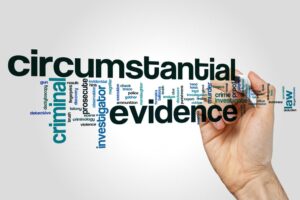Evidence is the backbone upon which cases stand or fall. However, understanding circumstantial evidence in the context of your legal situation is quite tricky.
Unlike direct evidence, which directly proves or disproves a fact, this evidence relies on inference and assumptions to support a conclusion.
But just because the evidence is not direct does not mean it is less credible. Many cases are built solely on circumstantial evidence and have resulted in convictions.
Whether a plaintiff or defendant, knowing the nuances of this type of evidence can help a criminal defense lawyer fully evaluate its impact on a civil or criminal case.
What Makes Evidence Circumstantial?
Circumstantial evidence requires interpretation or inference to reach a reasonable conclusion.
For example, if a witness testifies that they saw the defendant purchasing materials for making a bomb, this would constitute circumstantial evidence.
It does not directly prove that the defendant made a bomb, but a jury might infer from this statement that they had the intent and means to do so.
Circumstantial evidence can include:
Physical evidence. This includes fingerprints or DNA that connect a defendant to a crime scene or victim. In these cases, the inference is made that the person was present when the crime occurred and likely played a role, if not directly responsible.
Documentary evidence. Any documents, records, or text messages that support an inference of guilt can be considered circumstantial. These records can establish patterns and connections to support a reasonable conclusion.
Behavioral evidence. This includes actions and behaviors that suggest guilt or involvement in a crime, such as fleeing the scene or attempting to destroy evidence. By examining a person’s actions, inferences can be made about their motives and involvement in a crime.
Because this evidence is often subject to scrutiny and challenges in court, choosing an experienced criminal defense attorney who can effectively argue its validity and relevance in your case is crucial.
Admissibility In Court
The admissibility of circumstantial evidence varies across jurisdictions.
Generally, courts will admit it, provided it meets the following criteria:
- Relevance: The evidence must logically connect to the case and help determine the truth.
- Probative Value: The evidence must prove or disprove a fact relevant to the case.
- Reliability: The court should demand reliable and trustworthy evidence with minimal chance of falsehood or misleading information.
- Prejudice: Its potential to influence the jury unfairly should not outweigh the probative value of the evidence.
- Hearsay: Courts may not admit evidence that relies on hearsay (information heard from someone else rather than personally witnessed).
Proving beyond a reasonable doubt that evidence is or is not valid requires thorough investigation, analysis, and persuasive arguments to present the evidence effectively in court.
The Pros and Cons of Circumstantial Evidence
Collaborative Nature
The collaborative nature of circumstantial evidence means it can bolster a case when combined with other evidence.
For example, direct evidence, such as eye-witness testimony may confirm a defendant was at the scene of the crime.
At the same time, circumstantial evidence, such as motive, can establish their involvement to support the burden of proof beyond a reasonable doubt.
Open to Interpretation
Due to its reliance on inference and assumptions, circumstantial evidence is subject to interpretation and can be challenged by either party.
Therefore, hiring a criminal law attorney who can effectively argue the validity and relevance of circumstantial aspects in your case is essential.
Higher Burden of Proof
While circumstantial evidence can be as strong as direct evidence, it often requires a higher burden of proof.
This means legal counsel must work harder to convince the jury that the inference benefits or disproves each person’s case beyond a reasonable doubt.
Circumstantial Evidence: A Brief History of Notable Cases
United States v. Ramirez-Rodriguez
This notable case relied heavily on circumstantial evidence. The defendant was accused of importing and distributing controlled substances, but there was no direct evidence linking him to the crime.
Instead, the prosecution presented circumstantial evidence, such as bank records, phone records, and witness testimony, to prove its case beyond a reasonable doubt.
Despite the lack of direct evidence, the jury found Ramirez-Rodriguez guilty, and he was sentenced to five years in prison and four years probation.
The Supreme Court upheld this ruling despite Rodriguez’s appeals, deciding circumstantial evidence can prove guilt beyond a reasonable doubt just as well as direct evidence.
People v. Scott Peterson
In this highly publicized case, circumstantial evidence played a crucial role in the conviction of Scott Peterson for the murder of his wife and unborn child.
Despite no direct evidence linking him to the crime, circumstantial factors such as financial struggles, erratic behavior, and infidelity pointed to Peterson’s guilt.
The jury found him guilty and sentenced him to life in prison without the possibility of parole. Scott Peterson’s sentencing is a prime example of how this evidence can build a solid and persuasive case beyond a reasonable doubt.
The Case of Sacco & Vanzetti
This infamous case from the 1920s is a prime example of how circumstantial evidence creates a cloud of doubt and controversy in verdicts.
The two Italian immigrants were convicted of robbery and murder based on perceived consciousness of guilt, analogous clothing found at the scene, and a bullet case that matched a gun owned by one of the defendants.
Despite witness testimony contradicting the prosecution’s case, Sacco and Vanzetti were still found guilty and sentenced to death. However, many believe that they were unfairly convicted due to their nationality and political beliefs.
The case sparked international outrage. It forms a cautionary tale about the importance of thoroughly examining circumstantial evidence and avoiding biases or assumptions in its interpretation.
Circumstantial Evidence Making Your Case Challenging? Consult an Experienced Criminal Law Attorney.
Circumstantial evidence may or may not be the most substantial component of a case, but it can certainly play a crucial role in proving or disproving guilt.
Though not foolproof, developing the right strategy in court to make the most of this evidence can be a game-changer in your legal case.
Schedule your free consultation with an award-winning criminal law attorney and protect your rights to a fair trial.
Need more advice on criminal law? Check out The Atticus Files to browse our library of legal articles.



